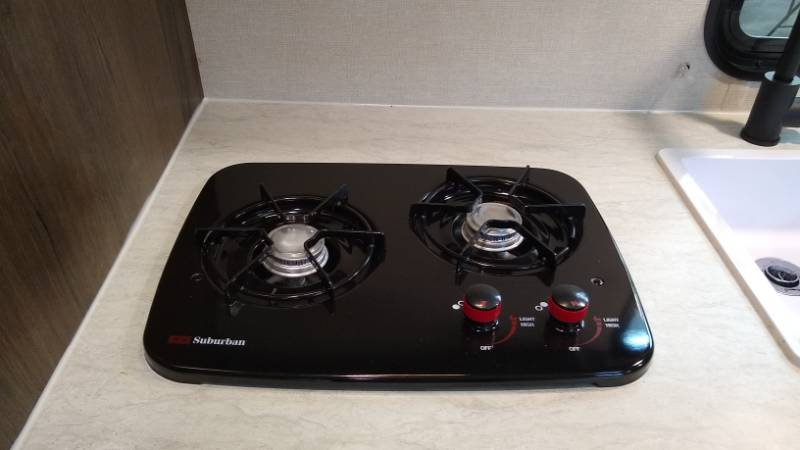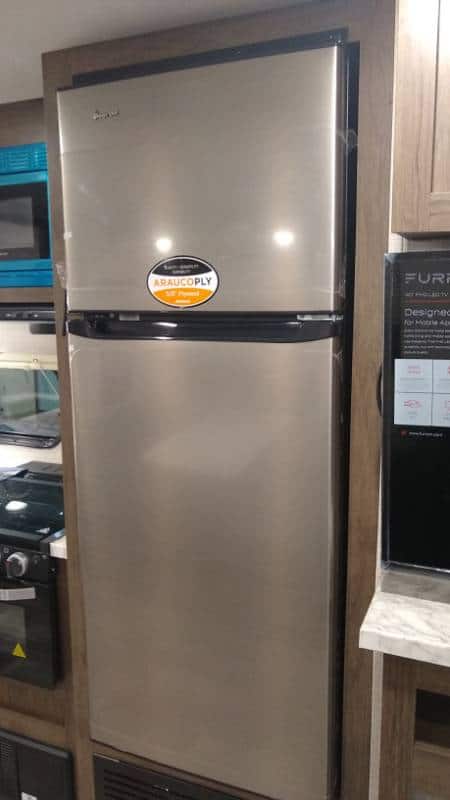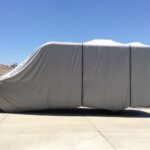How long does RV propane last?
This is, truly, a question that can keep you up at night – especially if you run out of fuel and the furnace turns off!
RVs use propane to power absorption refrigerators, furnaces, stoves and water heaters.
Without propane, your RV cannot function well. Many of the appliances will not work.
If you’re considering boondocking or dry camping, you might be wondering, “How long will my propane last?”
It’s a simple question. An accurate answer is quite complicated to calculate. But with the Changing Gears RV Propane Life calculator, you can get a back-of-the-envelope calculation pretty quick!
Table of Contents
RV Propane 101
Let’s begin with some simple, trustyworthy facts.
RVs use propane to power absorption refrigerators, furnaces, stoves and water heaters.
Propane is an incredible fuel. It is made from refined liquified petroleum. It is non-toxic, burns cleanly, and contains an enormous amount of energy. It is an odorless gas; the sulfurous smell is an added safety odorant called mercaptan.
At standard temperature and pressure, it is a heavier-than-air gas. Between 2.15 and 9.60% concentration in air, it is flammable and somewhat explosive. That’s why all RVs are required to have an LP detector mounted near floor level.
The propane inside your tanks is stored at enormous pressure to keep the propane in a liquid state. Once the LP passes through your 2-stage regulator, it turns into a gas.
To learn more technical information about propane, visit this page at Propane101.com.
- A single gallon of propane contains 91,548 BTUs. A BTU is the energy required to raise one pound of water by 1 degree Fahrenheit.
- A single gallon of propane weighs about 4.24 lbs.
What Appliances Use Propane?




Absorption Refrigerators
Absorption refrigerators use a propane flame to heat an ammonia refrigerant. This is the preferred method of operation. As a backup, most absorption refrigerators (known as 3-way fridges) also have an electrical heating element that can be operated by 12VDC (battery) or 120VAC (shore power) electricity.
Refrigerators use surprisingly little propane! Unless the interior of your RV is very warm, the refrigerator will cycle off/on when it detects a noticeable increase in the cooling compartment temperature. The smallest RV fridges may only consume 200-400 BTUs when operating in LP cooling mode; the largest ones may consume up to 2,200 BTUs at maximum cooling power.
Unlike your fridge at home, an absorption refrigerator usually cannot maintain a set temperature. Expect temperature fluctuations, especially when first cooling or when the ambient air is 80 degrees or higher.
Some modern RVs, especially larger ones, may use compressor refrigerators, which don’t consume any propane.
Furnaces
Blower furnaces are simple heat exchangers that blow hot air, heated by a propane flame, through the interior of your RV.
Most RVs only have a single furnace, but some may have two or more!
Most RV furnaces are ducted, either through the floor or the ceiling. All furnaces require a return air path.
Size of furnace varies widely. The smallest are 8,000-10,000 BTU. Most average around 16,000-25,000, while the largest are 40,000-50,000 BTU.
Furnaces are gas hogs. They deplete your propane faster than any other appliance. Like a refrigerator, they don’t run continuously; they’ll cycle off and on, perhaps for 10-15 minutes every hour. At night, they’ll tend to run more, which can be disturbing to light sleepers if the furnace is located next to the bed.
Stovetops
RV stoves are simple low-pressure burners.
Gas propane, which should be regulated to 10-11″ w.c. (or about 0.4 psi), is piped to the burners through the propane manifold system. Once ignited – either through electric, piezoelectric, mechanical or manual ignition – the stove burns on its own. You adjust the heat by increasing or decreasing the rate of propane flow.
Burners are commonly rated for 5,000 to 7,200 BTU at maximum floor. High-output burners may put out 10,000 BTU, while simmer-only burners may only put out 3,000 BTU or so.
Most RV stoves are 2-burner designs, although larger kitchens may have 3-burner stoves. Small stovetops may only accommodate a 7-inch and a 9-in pan, but larger stovetops may accommodate two 9-inch skillet pans – or even larger!
Stoves don’t consume very much propane when cooking. A little bit goes a long way! Same story for any appliance you connect to the exterior quick-connect propane fitting; it’s unlikely to consume a significant amount of propane.
Water Heaters
RV water heaters come in two types:
Storage Tank – Type
A run-of-the-mill RV water heater holds 6 gallons of water. Larger units hold 10 gallons of water.
That’s not a lot, so RV showers tend to be short n’ sweet, or even Navy-style.
Storage water heaters can only recover so fast. Most can produce 7-10 gallons per hour. So if you exhaust the hot water in the tank – for instance, by taking a shower – you’ll need to wait 20-30 minutes until the heater has recovered.
Tankless – Type
Somewhat new to the RV world are tankless water heaters. These units have no tank, just a super-hot heating element that warms up water as it passes by.
When done correctly, tankless water heaters are great! They provide instant hot water, with no wait or recovery time. If you want to take a 30-minute hot shower and empty your entire freshwater tank, no one will stop you. They are also more efficient, since no propane is used during standby.
Cheaper versions of tankless heaters fail to live up to these promises, though. Cheap aftermarket heaters may only heat water 20 or 30 degrees. Some have no feedback systems, which means the water temperature must be regulated manually. You get what you pay for.
In severe cold weather, while boondocking, expect a 20-lb tank of propane to last 3-7 days.
In typical summer camping, while camping at developed or primitive campsites, expect a 20-lb tank of propane to last 21-35 days.
How Long Will My RV Propane Last?
There is no one-size-fits-all answer to this question.
If boondocking in the winter, cooking meals inside and enjoying toasty warm nights, you can run out of propane in a weekend.
If staying at a campground over the summer, enjoying the campground shower house and cooking meals over a fire, you might only refill your tank[s] once a year!
Instead, let’s look at the principles and players in this equation.
Who Are the Big Hitters?
The two appliances that consume the most propane are your furnace and water heater.
Many RVs are rather drafty and poorly insulated. Even well-built RVs may have single-pane windows, which allow a lot of heat to escape. Running your furnace is necessary for your comfort and survival. If you’re camping in the winter, expect to consume a lot of propane! Especially if you’re camping at sub-freezing temperatures – you’ll need to keep your RV warm enough to prevent pipes from freezing, even when you’re away.
Water heaters don’t consume enormous amounts of energy on standby. And washing dishes doesn’t typically use more than a gallon or two of water. What really makes a difference are showers. If you’re trying to conserve propane, take cold/lukewarm showers, shower at the campground bath house, or visit a truck stop.
All this to say there are really only two situations where you should expect to burn through a lot of propane:
- If you’re camping in cold weather (below 50 degrees), expect to consume a lot of propane. If you’re camping in frigid weather (below 32 degrees), then it gets even worse.
- If you’re living full-time in your RV, cooking and showering, expect to consume a lot of propane. Gauge your daily use carefully.
How the Math Works
Calculating exactly how long your propane will last can be challenging. Use this calculator as an estimate, but understand that no calculator can be truly accurate to within a day or so.
There are three parts to the equation:
- Summing your system tank capacity
- Identifying the BTU rating of each appliance in each mode
- Measuring how long each appliance is used and in which mode
Fortunately, step 1 is easy. Just add up the poundage of your onboard DOT or ASME propane tanks and reference the following list:
- 20# tank: 4.6 gallons
- 33# tank: 7.8 gallons
- 40# tank: 9.4 gallons
- 100# tank: 23.6 gallons
1: Propane gallons x 91,548 = Tank BTUs
Unfortunately, steps 2 and 3 are rather difficult. A stove, for instance, doesn’t have a constant BTU rating; it will consume different amounts of propane based on how hot the burner is. And an absorption fridge or furnace will cycle off and on based on the ambient temperature.
Essentially, it can be difficult to know the exact average “run-time” of each appliance.
That’s where the calculator comes in! We’ve made some estimations for you so you don’t have to do all that math and measuring. You just tell us the sticker rating of your appliance, and we do the rest.
If you do your own math, then step 2 is:
2: Tank BTUs divided by total appliance BTU usage = hours of use
Again, this will vary by conditions. Your furnace will burn more propane at 40 degrees than 57; in fact, it’ll burn more if people keep walking in and out of the front door! Even changing the location of the thermostat has an effect. Read more below.
How Does Temperature Affect My Propane?
Propane won’t turn into a vapor at -44 degrees Fahrenheit. No vapor = no gas pressure = no propane in your RV!
Thankfully, you probably don’t camp in -44 degree weather. However, the colder propane gets, the slower it will vaporize.
This becomes a particular problem as your tank gets lower. In severe winter conditions, even a 30% full tank may be unable to turn on your furnace, simply because the propane cannot vaporize fast enough to keep up with demand!
| Propane Tank Vaporization Table - BTUs Available | |||||
|---|---|---|---|---|---|
| 20-LB DOT PROPANE BOTTLE | |||||
| % FULL | +20F | 0F | -5F | -10F | -15F |
| 60 | 36000 | 18000 | 12750 | 8500 | 4250 |
| 50 | 32400 | 18200 | 12150 | 8100 | 4050 |
| 40 | 28800 | 14400 | 11400 | 7600 | 3800 |
| 30 | 25200 | 12600 | 10450 | 7300 | 3150 |
| 20 | 21600 | 10800 | 8100 | 5400 | 2700 |
| 10 | 16200 | 8100 | 6075 | 4050 | 2025 |
| 30-LB DOT PROPANE BOTTLE | |||||
| % FULL | +20F | 0F | -5F | -10F | -15F |
| 60 | 50400 | 25200 | 17850 | 11900 | 5950 |
| 50 | 45360 | 25480 | 17010 | 11340 | 5670 |
| 40 | 40320 | 20160 | 15960 | 10640 | 5320 |
| 30 | 35280 | 17640 | 14630 | 10220 | 4410 |
| 20 | 30240 | 15120 | 11340 | 7560 | 3780 |
| 10 | 22680 | 11340 | 8505 | 5670 | 2835 |
| 40-LB DOT PROPANE BOTTLE | |||||
| % FULL | +20F | 0F | -5F | -10F | -15F |
| 60 | 60120 | 30060 | 21293 | 14195 | 7098 |
| 50 | 54108 | 30394 | 20291 | 13527 | 6764 |
| 40 | 48096 | 24048 | 19038 | 12692 | 6346 |
| 30 | 42084 | 21042 | 17452 | 12191 | 5261 |
| 20 | 36072 | 18036 | 13527 | 9018 | 4509 |
| 10 | 27054 | 13527 | 10145 | 6764 | 3382 |
Tips for Making My Propane Last Longer
- Shower with cold/lukewarm water.
- Or shower in the campground bathhouse!
- Or shower in the sun!
- Wash dishes with cold/lukewarm water.
- Use hot water only for greasy, dirty, grimy dishes.
- Use portable catalytic propane heaters or ceramic space heaters to heat small spaces.
- Use skirting around the base of your camper in cold weather.
- Invest in solar panels and an upgraded battery bank to run your water heater or fridge purely off electricity.
- Set your furnace temperature to 50 degrees and bundle up!
- Insulate and draft-proof your RV windows and ceiling fans
*ALERT!*
As of January 8, 2024, this interactive RV calculator is temporarily suspended. We apologize for the inconvenience, and we hope to have the calculator back up and running soon. In the meantime, we recommend reading through the rest of the notes on this page, which may help clarify your understanding. Thank you for visiting Changing Gears.







